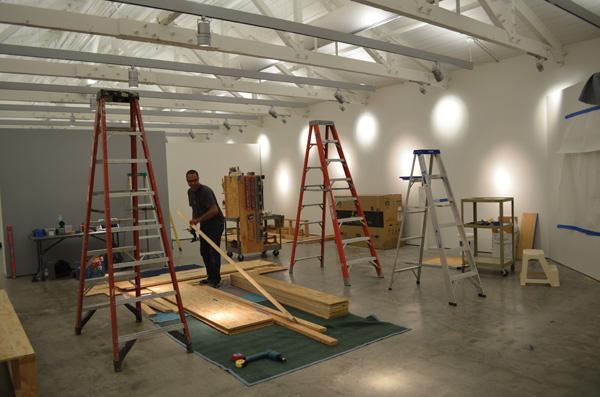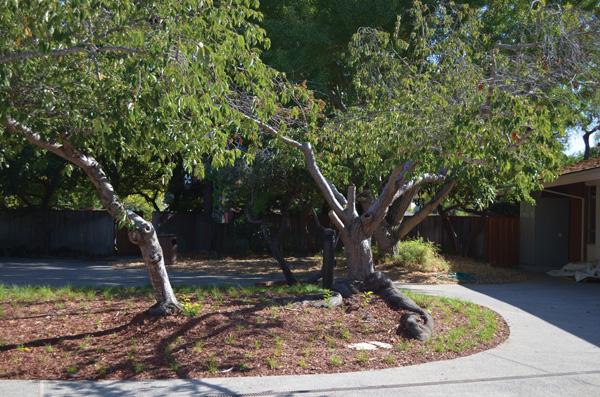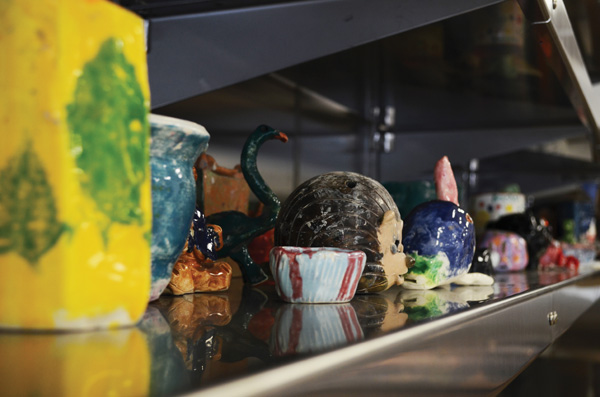
Boxes line the entrance to the wet-paint scented lobby as Palo Alto Art Center employees and construction workers hustle about putting the final touches for the reopening of the center. The sound of their conversations echo off the high ceilings and drift through to the main gallery. In the remodeled gallery, artists prepare for the Oct. 6 reopening day of an institution that has been a part of the Palo Alto community for the past 40 years.
Building a New Art Center
Over the past 18 months, the Art Center has undergone a complete transformation and upgrade of its facilities, a change made possible by $7.9 million from public, private and government sponsors.
The most significant changes include raised ceilings and new, state-of-the-art lighting in the main gallery of the center.
The outdoor setting has also been updated. The back courtyard was designed by SWA Group, the designers of San Francisco’s California Academy of Sciences living roof. The Center wanted to create an outdoor atmosphere that was more sustainable and usable for its guests.

The building, originally built as a government office space in 1953, was retrofitted in 1971 and has been a part of the Palo Alto community for the past 40 years.
“There was community interest in turning the building into an art center,” Palo Alto Art Center Director Karen Kienzle says. “It was created by the community, for the community.”
Over time the center became dated architecturally, which is one of the main reasons for the recent renovations. Thanks to the designs of the SWA Group and many others as well, the Palo Alto Art Center is now a modern representation of what it has always been, a place where the Peninsular community can observe and create art.

Kathy Aoki has been working on an exhibit called TeenScapes that focuses on the life of the average teen for the upcoming reopening of the Art Center.
The piece uses a mixture of painting and installation to create a three-dimensional representation of teen life. Aoki has also incorporated a peephole format into the display that enhances the viewer’s experience and connection to the work.
“The peephole offers a larger landscape, suggests mystery, and can be more easily controlled in terms of scale and lighting than a life size scene,” Aoki says. “Plus, the peephole has a certain amount of distortion which helps to provide a sense of depth.”
Aoki was aided by Palo Alto High School senior Elani Gitterman to assist her creatively, as well as in the building the TeenScapes exhibit.
“I’ve been helping Kathy Aoki with her project which will be on display at the opening of the Art Center. I helped her brainstorm for ideas and am helping her build the actual piece right now, and I’m excited to see our finished product on display at the gallery opening,” Gitterman says.
Working with teenagers on a piece about teenagers allowed Aoki to get input from the source and helped her create the final product.
“The students brought art skills and ideas that enhanced the project throughout the creation process,” Aoki says. “As we worked together, more and more suggestions came from the students. I completely rely on their eyes and opinions of the project as we move forward.”
Green Initiative
The Art Center also has kept up with maintaining its green image, and making sure that every update is efficient, multi-functional and aesthetically pleasing.
The main entrance will house the Judith Content pottery project, with landscaping material created from discarded and broken pottery, showcasing the Center’s idea of recycling objects to create something new and environmentally friendly. “Judith begins by hitting the pottery with a hammer to break it into shards,” Kienzle says. “Then she puts the shards into tumblers, where they tumble around and it results in a great landscaping material. It’s going to be a colorful and really wonderful landscaping material that connects directly to our program.”
The Center also boasts new double-paned windows that will insulate the building and cut energy costs. Outdoor seating areas and decks are made of a recycled plastic called Trex. The Center has incorporated a material made of compressed paper known as paperstone into the customer greeting area, and throughout the art classrooms.
“We did not increase the [carbon] footprint of the Art Center through this renovation,” Kienzle says. “[The renovation] was really about making the existing spaces that we have more functional, as well as more pleasing.”
On the Road
While the center was going through construction, an alternative program was created to continue to engage and educate the public in the arts in its absence.
The moving art truck has expanded the center’s audience with outdoor and community involved exhibits. By creating a travelling art exhibition, the Center was able to bring its message to new audience and maintain its following.
“The goals of On the Road were to keep the center alive in our community when we didn’t have the building,” Kienzle says. “It was really wonderful for us to continue our program in the community. The intention of On the Road was to continue to reach out to new audiences and to bring them all back to the Art Center when we reopened.”
On the Road provides a distinctive experience for the people of Palo Alto and creates opportunities for those who may not normally visit the center to view pieces of art by prominent local artists.
Opening Day
The final step in the reopening of the Palo Alto Art Center will include a ribbon cutting ceremony, followed by hands-on activities, led by Art Center employees, for guests of all ages. The new logo, designed by Colleen Sullivan, a member of the Cubberly Artists Studio Program, will be revealed in an exhibition along with other logo entries.
The reopening will include food trucks, faculty demonstrations and workshops to get the public interested in upcoming art classes, and two performances from both an Indian dancing group from Palo Alto and the India Community Center in Milpitas.
Community Creates!, the inaugural exhibition for the reopening, consists of installations by 10 local, prominent and emerging contemporary artists who required community participation. The exhibit provides a unique glimpse into the people and community of Palo Alto.
“The day is going to start off with a dedication ceremony that will include speeches by various dignitaries,” Kienzle says. “Then a ribbon cutting. We are really excited about getting the community back to Art Center.”


